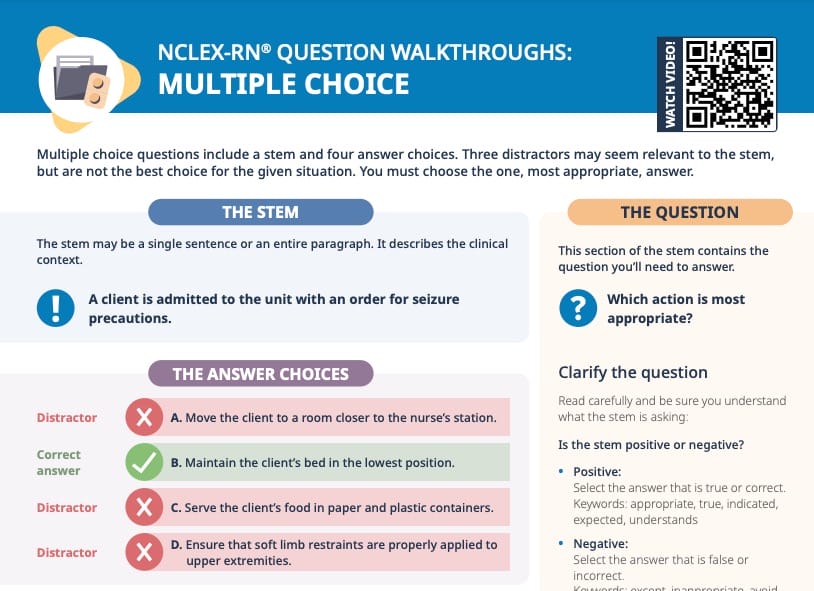#1 Analyze the question stem
Evaluate the cues and assessments
The client is showing the following abnormal respiratory assessments:
- Increased respiratory rate
- Use of accessory muscles to breathe: indicates distress and inadequate oxygenation
- PaO2 of 56: that is very low. Normal values are about 80 to 100.
Those cues together let us form the hypothesis that this patient is in respiratory distress.
Rephrase the question in your own words
You are dealing with a client that is showing abnormal respiratory assessment results (the increased respiratory rate, the use of accessory muscles to breathe, and the low PaO2) which lead to the client being in respiratory distress. So, this is what needs to be addressed by the nurse’s action. According to the information in the question, the Venturi mask has not helped much. So, what do you try next?
#2 Evaluate the answer options and eliminate the ones you think must be false (“distractors”)
Tip: Go through all the answer options and eliminate answers you think to be false. Do not gravitate toward answer choices. Keep the ones you are not sure about or think might be correct, and go through those again after eliminating all the ones you’re sure are false.
Rephrase: The patient is experiencing respiratory distress and the Venturi mask has not been helping. What is the next step to take to help the patient?
A. An invasive method of oxygen delivery, such as bilevel positive airway pressure (BiPAP)
Tip: When you read through all the answer options at first (which you always should do!), you will have noticed the first 3 are really similar – they are all about BiPAP. While it is tempting to think the one “different” answer is the correct one, don’t fall for this trap! It could be any of the answers. Instead, focus on the minor differences between them: this is what is expected of you to recognize on the NCLEX.
Read closely – it says an “invasive method such as BiPAP,” but BiPAP is not invasive. So, this answer option can be eliminated.
B. The need for a method of lower-level pressure delivery during inhalation and a higher pressure during exhalation, which BiPAP can provide
Might be correct – let’s come back to this one after going through the rest of the options and eliminating the ones we are sure are false.
C. BiPAP, because it reduces the need for intubation and mechanical ventilation
Might be correct – let’s come back to this one after going through the rest of the options and eliminating the ones we are sure are false.
D. Continuous positive airway pressure (CPAP), because it delivers a constant level of pressure to reduce the effort of breathing
CPAP is often used for clients with sleep apnea to keep the airways open – it would not be helpful here. So, this option is disqualified and we go back to look at the answers we kept – B and C.
#3 Look at the ones you did not eliminate and choose your answer
“B. The need for a method of lower-level pressure delivery during inhalation and a higher pressure during exhalation, which BiPAP can provide”:
No, actually, BiPAP delivers the opposite of this statement: higher pressure during inhalation and lower pressure during exhalation! So, this answer option is wrong.
Tip: Really imagining, playing out the answer choice in your head can help you focus better and really understand it. Lower pressure when inhaling and higher pressure when exhaling? When you imagine that in your head, it does not make sense.
“C. BiPAP, because it reduces the need for intubation and mechanical ventilation”:
Yes, BiPAP does decrease the need for intubation. So, this answer is the only one that is left over, and it makes sense! So, this one must be the correct answer.
#4 Recap: tips for NCLEX multiple choice questions
- Always read through all the answer choices first.
- Work through the answer choices by eliminating distractors, without trying to choose the correct one immediately.
- Then, look through the ones you don’t eliminate immediately in detail. Use your imagination to grasp what they mean to figure out which one makes sense.
- When several answer choices seem very similar to each other, don’t discard them – focus in on their differences. If they do say the same thing in different phrasing, they can usually be eliminated.
Following the steps above might seem very time-consuming. But, answering NCLEX-style questions is a matter of practice – follow the method closely at first and you will internalize the strategy of answering questions thoroughly and become faster as you practice! This will help you always know WHY you choose an answer and be much more confident in your answer choices.
Tip: Imagine you are doing brain surgery: you want to dissect everything in detail. Look at taking the NCLEX the same way – you want to make the tiniest incisions to get the best results – look at each answer choice in detail and think it through.
